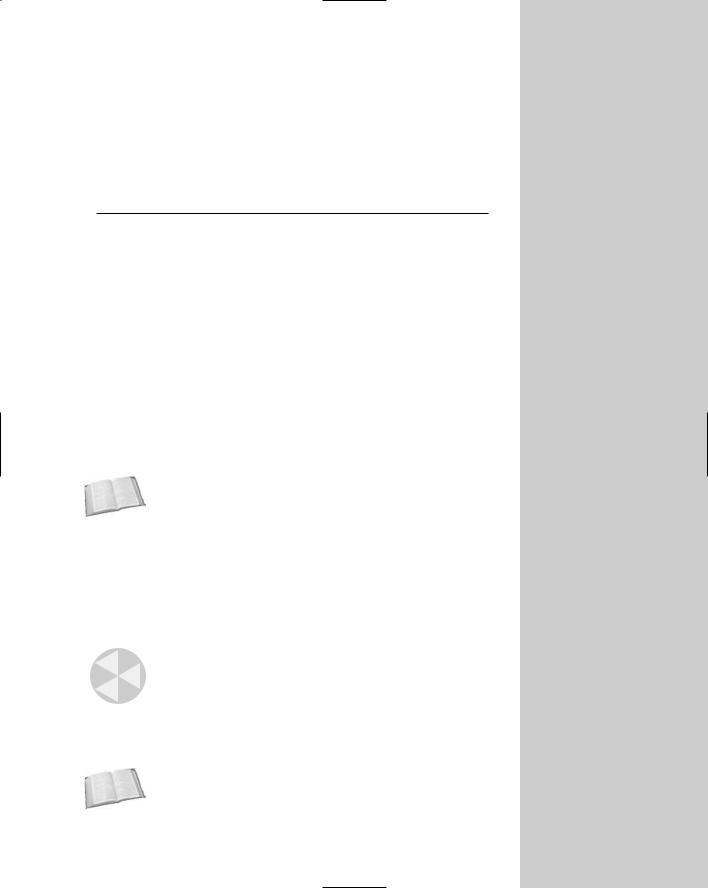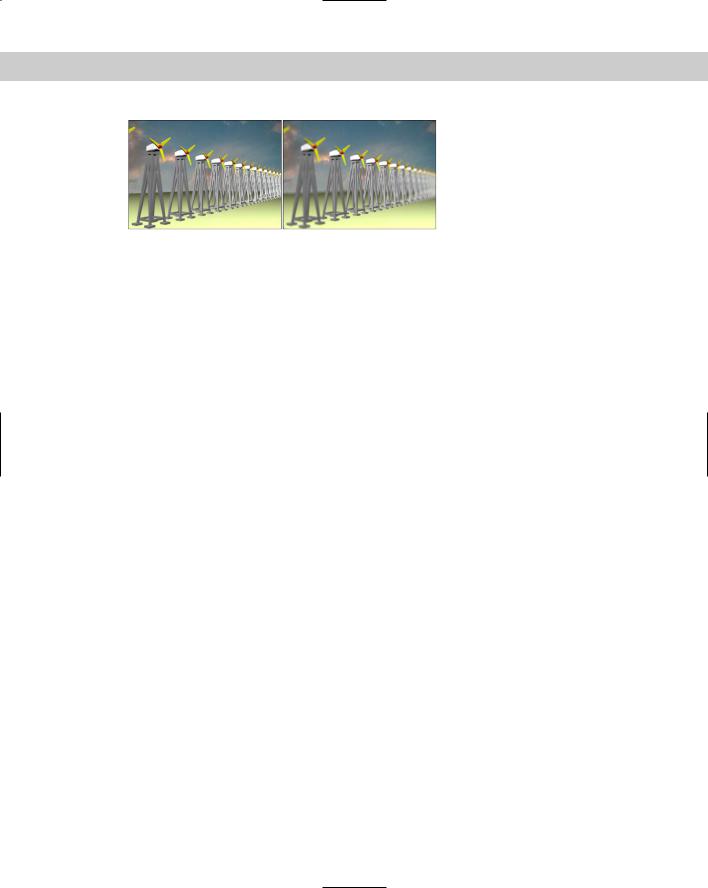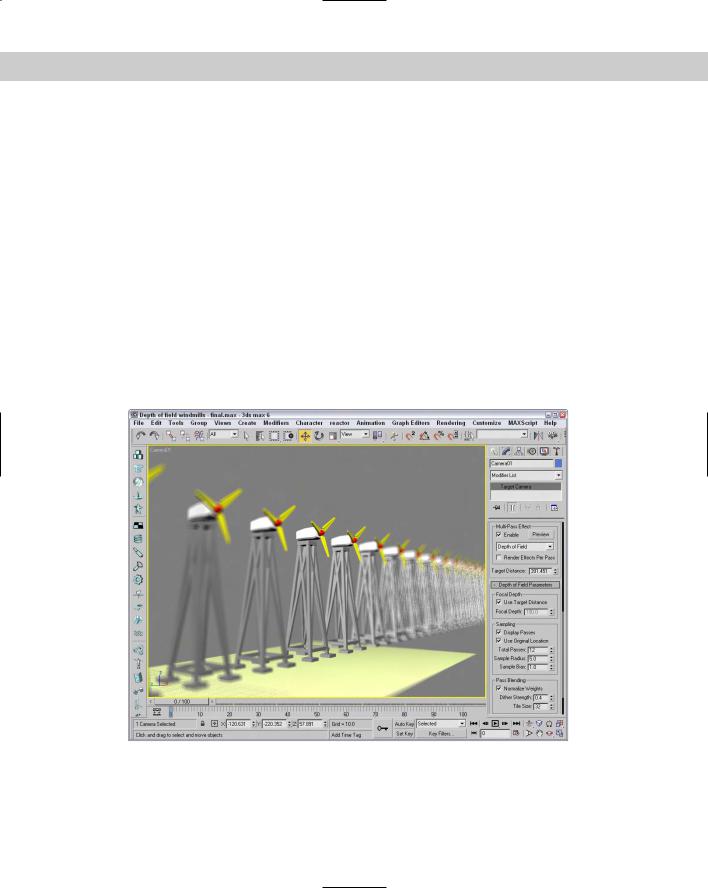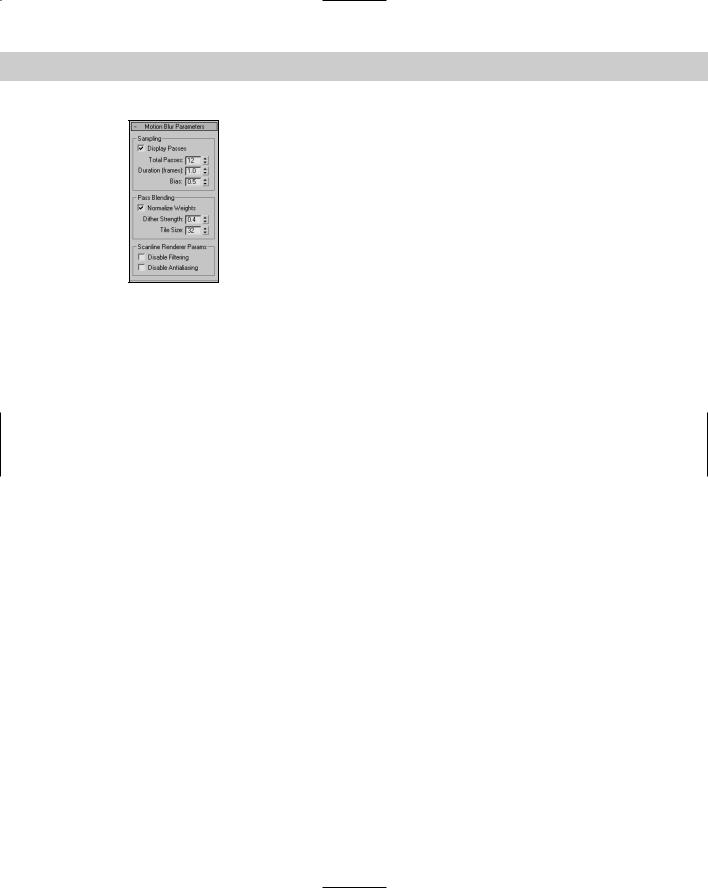
- •Preface
- •About This Book
- •Acknowledgments
- •Contents at a Glance
- •Contents
- •Relaxing at the Beach
- •Dressing the Scene
- •Animating Motion
- •Rendering the Final Animation
- •Summary
- •The Interface Elements
- •Using the Menus
- •Using the Toolbars
- •Using the Viewports
- •Using the Command Panel
- •Using the Lower Interface Bar Controls
- •Interacting with the Interface
- •Getting Help
- •Summary
- •Understanding 3D Space
- •Using the Viewport Navigation Controls
- •Configuring the Viewports
- •Working with Viewport Backgrounds
- •Summary
- •Working with Max Scene Files
- •Setting File Preferences
- •Importing and Exporting
- •Referencing External Objects
- •Using the File Utilities
- •Accessing File Information
- •Summary
- •Customizing Modify and Utility Panel Buttons
- •Working with Custom Interfaces
- •Configuring Paths
- •Selecting System Units
- •Setting Preferences
- •Summary
- •Creating Primitive Objects
- •Exploring the Primitive Object Types
- •Summary
- •Selecting Objects
- •Setting Object Properties
- •Hiding and Freezing Objects
- •Using Layers
- •Summary
- •Cloning Objects
- •Understanding Cloning Options
- •Mirroring Objects
- •Cloning over Time
- •Spacing Cloned Objects
- •Creating Arrays of Objects
- •Summary
- •Working with Groups
- •Building Assemblies
- •Building Links between Objects
- •Displaying Links and Hierarchies
- •Working with Linked Objects
- •Summary
- •Using the Schematic View Window
- •Working with Hierarchies
- •Setting Schematic View Preferences
- •Using List Views
- •Summary
- •Working with the Transformation Tools
- •Using Pivot Points
- •Using the Align Commands
- •Using Grids
- •Using Snap Options
- •Summary
- •Exploring the Modifier Stack
- •Exploring Modifier Types
- •Summary
- •Exploring the Modeling Types
- •Working with Subobjects
- •Modeling Helpers
- •Summary
- •Drawing in 2D
- •Editing Splines
- •Using Spline Modifiers
- •Summary
- •Creating Editable Mesh and Poly Objects
- •Editing Mesh Objects
- •Editing Poly Objects
- •Using Mesh Editing Modifiers
- •Summary
- •Introducing Patch Grids
- •Editing Patches
- •Using Modifiers on Patch Objects
- •Summary
- •Creating NURBS Curves and Surfaces
- •Editing NURBS
- •Working with NURBS
- •Summary
- •Morphing Objects
- •Creating Conform Objects
- •Creating a ShapeMerge Object
- •Creating a Terrain Object
- •Using the Mesher Object
- •Working with BlobMesh Objects
- •Creating a Scatter Object
- •Creating Connect Objects
- •Modeling with Boolean Objects
- •Creating a Loft Object
- •Summary
- •Understanding the Various Particle Systems
- •Creating a Particle System
- •Using the Spray and Snow Particle Systems
- •Using the Super Spray Particle System
- •Using the Blizzard Particle System
- •Using the PArray Particle System
- •Using the PCloud Particle System
- •Using Particle System Maps
- •Controlling Particles with Particle Flow
- •Summary
- •Understanding Material Properties
- •Working with the Material Editor
- •Using the Material/Map Browser
- •Using the Material/Map Navigator
- •Summary
- •Using the Standard Material
- •Using Shading Types
- •Accessing Other Parameters
- •Using External Tools
- •Summary
- •Using Compound Materials
- •Using Raytrace Materials
- •Using the Matte/Shadow Material
- •Using the DirectX 9 Shader
- •Applying Multiple Materials
- •Material Modifiers
- •Summary
- •Understanding Maps
- •Understanding Material Map Types
- •Using the Maps Rollout
- •Using the Map Path Utility
- •Using Map Instances
- •Summary
- •Mapping Modifiers
- •Using the Unwrap UVW modifier
- •Summary
- •Working with Cameras
- •Setting Camera Parameters
- •Summary
- •Using the Camera Tracker Utility
- •Summary
- •Using Multi-Pass Cameras
- •Creating Multi-Pass Camera Effects
- •Summary
- •Understanding the Basics of Lighting
- •Getting to Know the Light Types
- •Creating and Positioning Light Objects
- •Viewing a Scene from a Light
- •Altering Light Parameters
- •Working with Photometric Lights
- •Using the Sunlight and Daylight Systems
- •Using Volume Lights
- •Summary
- •Selecting Advanced Lighting
- •Using Local Advanced Lighting Settings
- •Tutorial: Excluding objects from light tracing
- •Summary
- •Understanding Radiosity
- •Using Local and Global Advanced Lighting Settings
- •Working with Advanced Lighting Materials
- •Using Lighting Analysis
- •Summary
- •Using the Time Controls
- •Working with Keys
- •Using the Track Bar
- •Viewing and Editing Key Values
- •Using the Motion Panel
- •Using Ghosting
- •Animating Objects
- •Working with Previews
- •Wiring Parameters
- •Animation Modifiers
- •Summary
- •Understanding Controller Types
- •Assigning Controllers
- •Setting Default Controllers
- •Examining the Various Controllers
- •Summary
- •Working with Expressions in Spinners
- •Understanding the Expression Controller Interface
- •Understanding Expression Elements
- •Using Expression Controllers
- •Summary
- •Learning the Track View Interface
- •Working with Keys
- •Editing Time
- •Editing Curves
- •Filtering Tracks
- •Working with Controllers
- •Synchronizing to a Sound Track
- •Summary
- •Understanding Your Character
- •Building Bodies
- •Summary
- •Building a Bones System
- •Using the Bone Tools
- •Using the Skin Modifier
- •Summary
- •Creating Characters
- •Working with Characters
- •Using Character Animation Techniques
- •Summary
- •Forward versus Inverse Kinematics
- •Creating an Inverse Kinematics System
- •Using the Various Inverse Kinematics Methods
- •Summary
- •Creating and Binding Space Warps
- •Understanding Space Warp Types
- •Combining Particle Systems with Space Warps
- •Summary
- •Understanding Dynamics
- •Using Dynamic Objects
- •Defining Dynamic Material Properties
- •Using Dynamic Space Warps
- •Using the Dynamics Utility
- •Using the Flex Modifier
- •Summary
- •Using reactor
- •Using reactor Collections
- •Creating reactor Objects
- •Calculating and Previewing a Simulation
- •Constraining Objects
- •reactor Troubleshooting
- •Summary
- •Understanding the Max Renderers
- •Previewing with ActiveShade
- •Render Parameters
- •Rendering Preferences
- •Creating VUE Files
- •Using the Rendered Frame Window
- •Using the RAM Player
- •Reviewing the Render Types
- •Using Command-Line Rendering
- •Creating Panoramic Images
- •Getting Printer Help
- •Creating an Environment
- •Summary
- •Creating Atmospheric Effects
- •Using the Fire Effect
- •Using the Fog Effect
- •Summary
- •Using Render Elements
- •Adding Render Effects
- •Creating Lens Effects
- •Using Other Render Effects
- •Summary
- •Using Raytrace Materials
- •Using a Raytrace Map
- •Enabling mental ray
- •Summary
- •Understanding Network Rendering
- •Network Requirements
- •Setting up a Network Rendering System
- •Starting the Network Rendering System
- •Configuring the Network Manager and Servers
- •Logging Errors
- •Using the Monitor
- •Setting up Batch Rendering
- •Summary
- •Compositing with Photoshop
- •Video Editing with Premiere
- •Video Compositing with After Effects
- •Introducing Combustion
- •Using Other Compositing Solutions
- •Summary
- •Completing Post-Production with the Video Post Interface
- •Working with Sequences
- •Adding and Editing Events
- •Working with Ranges
- •Working with Lens Effects Filters
- •Summary
- •What Is MAXScript?
- •MAXScript Tools
- •Setting MAXScript Preferences
- •Types of Scripts
- •Writing Your Own MAXScripts
- •Learning the Visual MAXScript Editor Interface
- •Laying Out a Rollout
- •Summary
- •Working with Plug-Ins
- •Locating Plug-Ins
- •Summary
- •Low-Res Modeling
- •Using Channels
- •Using Vertex Colors
- •Rendering to a Texture
- •Summary
- •Max and Architecture
- •Using AEC Objects
- •Using Architectural materials
- •Summary
- •Tutorial: Creating Icy Geometry with BlobMesh
- •Tutorial: Using Caustic Photons to Create a Disco Ball
- •Summary
- •mental ray Rendering System
- •Particle Flow
- •reactor 2.0
- •Schematic View
- •BlobMesh
- •Spline and Patch Features
- •Import and Export
- •Shell Modifier
- •Vertex Paint and Channel Info
- •Architectural Primitives and Materials
- •Minor Improvements
- •Choosing an Operating System
- •Hardware Requirements
- •Installing 3ds max 6
- •Authorizing the Software
- •Setting the Display Driver
- •Updating Max
- •Moving Max to Another Computer
- •Using Keyboard Shortcuts
- •Using the Hotkey Map
- •Main Interface Shortcuts
- •Dialog Box Shortcuts
- •Miscellaneous Shortcuts
- •System Requirements
- •Using the CDs with Windows
- •What’s on the CDs
- •Troubleshooting
- •Index

676 Part V Cameras
Summary
The Camera Match and Camera Tracker utilities enable you to match your scene’s position and motion to a background image or animation. These features can be very helpful in creating realistic images and animations.
In this chapter, you’ve
Learned to use the Camera Match utility to match a camera to a background image
Controlled a camera’s position using the Camera Tracker utility
The next chapter covers the special effects that are possible with Multi-Pass cameras including Depth of Field and Motion Blur.
|
|
|

Multi-Pass Camera
Effects
In the Camera Parameters rollout is a section for enabling Multi-Pass Camera Effects. These effects include Motion Blur and Depth of
Field. Essentially, these effects are accomplished by taking several rendered images of a scene and combining them with some processing.
Using Multi-Pass Cameras
All cameras have the option to enable them to become multi-pass cameras. You can find these settings in the Parameters rollout when a camera object is selected. Multi-pass cameras are created by checking the Enable button and selecting the effect from the drop-down list. The current available effects include Depth of Field (mental ray), Depth of Field, and Motion Blur. For each, an associated rollout of parameters opens.
Cross- |
The Depth of Field (mental ray) effect option is covered in Chapter |
Reference |
44, “Raytracing and mental ray.” |
|
Creating Multi-Pass Camera Effects
The Multi-Pass Effect section of the Parameters rollout also includes a Preview button. This button makes the effect visible in the viewports. This feature can save you a significant amount of time that normally would be spent test-rendering the scene. The Preview button is worth its weight in render speed. Using this button, you can preview the effect without having to render the entire sequence.
Caution |
The Preview button does not work unless the Camera view is the |
|
active viewport. |
The Render Effect Per Pass option causes any applied Render Effects to be applied at each pass. If disabled, then any applied Render Effects is applied after the passes are completed.
26C H A P T E R
In This Chapter
Working with multi-pass cameras
Creating a Depth of Field effect
Creating a Motion
Blur effect
Cross- |
You can also apply these multi-pass effects as Render Effects. See |
Reference |
Chapter 43, “Using Render Elements and Effects.” |
|

678 Part V Cameras
Using the Depth of Field effect
The Depth of Field Parameters rollout, shown in Figure 26-1, appears when the Depth of Field option is selected in the Multi-Pass Effect section of the Parameters rollout. It includes settings for controlling the Depth of Field multi-pass effect.
Figure 26-1: Use the Depth of Field Parameters rollout to set the number of passes.
You can select to use the Target Distance (which is the distance to the camera’s target), or you can specify a separate Focal Depth distance. This location is the point where the camera is in focus. All scene objects closer and further from this location are blurred to an extent, depending in their distance from the focal point.
Note Even free cameras have a Target Distance. This distance is displayed at the bottom of the Parameters rollout.
Within the Depth of Field Parameters rollout, you also have the option to display each separate pass in the Rendered Frame Window with the Display Passes option and to use the camera’s original location for the first rendering pass by enabling the Use Original Location option.
The Total Passes is the number of times the scene is rendered to produce the effect, and the Sample Radius is the potential distance that the scene can move during the passes. By moving the scene about the radius value and re-rendering a pass, the object becomes blurred more away from the focal distance. If you have a fairly tight scene, the default
Radius value does not produce very visible results. Try increasing the Sample Radius value and re-rendering. Figure 26-2 shows a scene with Sample Radius values of 1 and 5.
Note The Depth of Field effect is applied only to scene objects that are rendered. They are not applied to any background images.

Chapter 26 Multi-Pass Camera Effects 679
Figure 26-2: Changing the Sample Radius value changes the amount of blur added to the scene.
The Sample Bias value moves the blurring closer to the focal point (for higher values) or away from the focal point (for lower values). If you want to highlight the focal point and radically blur the other objects in the scene, set the Sample Bias to 1.0. A Sample Bias setting of 0 results in a more even blurring.
The Normalize Weights option allows you to control how the various passes are blended. When enabled, you can avoid streaking along the object edges. The Dither Strength value controls the amount of dither taking place. Higher Dither Strength values make the image grainier. The Tile Size value also controls dither by specifying the dither pattern size.
With lots of passes specified, the render time can be fairly steep. To lower the overall rendering time, you can disable the Anti-alias and Anti-alias filtering computations. These speed up the rendering time at the cost of image quality.
Tutorial: Applying a Depth of Field effect to a row of windmills
In the dry plains of Southwest America, the wind blows fiercely. Rows of windmills are lined up in an effort to harness this energy. For this example, we use the Depth of Field effect to display the windmills.
To apply a Depth of Field effect to a row of windmills, follow these steps:
1.Open the Depth of field windmills.max file from the Chap 26 directory on the CD-ROM.
This file includes a windmill object (created by Viewpoint Datalabs) duplicated multiple times and positioned in a row.
2.Select Create Cameras Target Camera, and drag in the Top viewport from the lowerleft corner to the center of the windmills. In the Left vewpoint, select the camera and move it upward, and then select the Camera Target and also move it upward, so the entire row of windmills can be seen.
3.Select the Perspective viewport, right-click on the viewport title, and select Views Camera01 (or just press the C key) to make this viewport the Camera view.
4.With the Camera selected, open the Modify panel, enable the Multi-Pass Effect option, and then select Depth of Field in the drop-down list.

680 Part V Cameras
5.In the Depth of Field Parameters rollout, enable the Use Target Distance option and set the Total Passes to 15, the Sample Radius to 3.0, and the Sample Bias to 1.0.
6.Select the Camera viewport, and click the Preview button in the Parameters rollout.
This shows the Depth of Field effect in the viewport.
Figure 26-3 shows the resulting Depth of Field effect in the viewport for the row of windmills.
Using the Motion Blur effect
Motion blur is an effect that shows motion by blurring objects that are moving. If a stationary object is surrounded by several objects that are moving, then the motion blur effect blurs the moving objects and the stationary object remains in clear view, regardless of their positions in the scene. The faster an object moves, the more blurry it becomes.
This blurring is accomplished in several ways, but with a multi-pass camera, the camera renders subsequent frames of an animation and then blurs the images together.
The Motion Blur Parameters rollout, shown in Figure 26-4, appears when the Motion Blur option is selected in the Multi-Pass Effect section of the Parameters rollout. Many of its parameters work the same as the Depth of Field effect.
Figure 26-3: Multi-Pass camera effects can be viewed in the viewport using the Preview button.

Chapter 26 Multi-Pass Camera Effects 681
Figure 26-4: For the Motion Blur effect, you can set the number of frames to include.
The Display Passes option displays the different frames as they are being rendered, and the Total Passes is the number of frames that are included in the averaging. You can also select the Duration, which is the number of frames to include in the effect. The Bias option weights
the averaging toward the current frame. Higher Bias values weight the average more toward the latter frames, and lower values lean toward the earlier frames.
The remaining options all work the same as for the Depth of Field effect.
Tutorial: Using a Motion Blur multi-pass camera effect
The motion blur effect works only on objects that are moving. Applying this effect to a stationary 2D shape does not produce any noticeable results. For this tutorial, you apply this effect to a speeding ‘57 Chevy model created by Viewpoint Datalabs.
To apply a motion blur multi-pass effect to the camera looking at a car mesh, follow these steps:
1.Open the Car at a stop sign.max file from the Chap 26 directory on the CD-ROM.
This file includes a car mesh (created by Viewpoint Datalabs), a camera, and a simple stop sign made of primitives. The car is animated.
2.Click the Select by Name button on the main toolbar to open the Select by Name dialog box (or press the H key). Double-click the Camera01 object to select it.
3.With the camera object selected, open the Modify panel. In the Multi-Pass Effect section of the Parameters rollout, click the Enable check box and select the Motion Blur effect from the drop-down list.
4.In the Motion Blur Parameters rollout, set the Total Passes to 10, the Duration to 1.0, and the Bias to 0.9.
5.Drag the Time Slider to frame 57. This is the location where the car just passes the stop sign.
6.With the Camera viewport active, click the Preview button in the Parameters rollout.
Figure 26-5 shows the results of the Motion Blur effect. This effect has been exaggerated to show its result. Notice that the stop sign isn’t blurred. The only problem with this example is that, with the Motion Blur effect enabled, you can’t make out the license plate number, so you can’t send this speeder a ticket.
